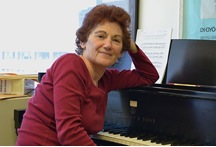Sheila Silver: Nocturne
Context
Sheila Silver is an American-born composer who grew up in Seattle. She began receiving piano lessons from the age of 5 and her love and passion for music grew and grew until she earned her place at the University of California, Berkeley. She graduated with a Bachelor of Arts in 1968. When she graduated she also won a the George Ladd Prix de Paris, which allowed her to study in Europe for the next two years.
During her bachelors, Silver started learning composition, so when she went to Europe (namely Stuttgart, Berlin and Hamburg), she was chiefly studying composition. Whilst in Berlin and Hamburg, she studied under prolific Hungarian composer, György Ligeti. Subsequently, she earned her doctorate from Brandeis University, which, during her course of research, allowed her to travel around the world.
Silver has worked with a wealth of different ensembles, a lot of which are highly acclaimed. For instance, she has had commissions from the LA Philharmonic, RAI Orchestra of Rome and the Muir Quartet. Silver has composed in a number of genres including large-scale orchestral works, concertos, solo works and choral music. Her compositional style is dynamic and colourful, and she uses her experience from different teachers which make her a stand-out composer of the modern-day. She has recently spent an extended period in India, learning the art of Hindustani music. Now, however, Silver lives in New York, with her husband John Feldman and their son. She is a Professor of Music at the State University, New York.
The Music
Nocturne is a work that Silver composed in 2015, and was consequently published by Argenta Music. The work is the product of a co-commission by the Chamber Music Society of Lincoln Centre for Gilbert Kalish. The piece is for solo piano and the New York Classical Review commented on the work saying:
“The music has a purely expressive quality, with a rocking bluesy, harmonic motion.”
Nocturne begins with a low pedal note, which is sustained, whilst the right hand plays a simple melodic figure, based around fundamental trill motif. This small cell of music is then varied until an interlude from the right hand is heard. A fast broken chord passage sings out from both hands, which gives an air of mystery.
The initial theme is heard again, except again it is a slight variation. A series of complex chord progressions are heard in the upper register of the piano, which leads into a trill in the left hand. An Alberti-esque bass line then begins, with the right hand playing a very blues-inspired melody. This section is based around syncopation which gives you the ‘on the edge’ feeling.
A pass-over between the left and right hand occurs, with the general tone being low and quite dark. The use of blue notes and trills seems to be a growing theme within this work for Silver. It gives a sense of familiarity and a central melodic and harmonic core within the piece.
The next section sounds very atonal, which gives a feeling of uncertainty that we have not heard yet. The next, more climactic section is louder and much more prevalent. Both hands are playing a moving line, so it is a much thicker texture. This breaks down into a chordal versus scalic section between the left and right hand. The occasional use of dissonance is extremely effective as it creates an ethereal atmosphere within the music. The right hand then starts playing scalic runs into the very top register of the piano, with the left hand still playing a consistent scalic pattern.

A small glissando is played and the trill motif is heard once more. The uncertainty hasn’t quite left, and this section reinforces that feeling. The left hand plays a moving line, whilst the right plays a small melody over the top. This leads to a passage in unison, which cuts the texture down significantly.
Silver’s use of the whole piano is also incredibly powerful, as it makes the work bold and colour in tone and texture. The texture stays very busy, with each hand going to opposite ends of the piano, and then eventually meeting each other in the middle again. The music still sounds rather atonal at this point. T
he left hand plays a darker passage in the lower end of the piano, with the right playing also in the lower end of the instrument. A tone motif is heard between two notes in the left hand, and this is accompanied by a chord in the right. The piece is at its lowest in pitch here and this motif eerily ends the work.
Ⓒ Alex Burns
Happy Reading!
You might also enjoy… Ruth Schönthal: Sonata, quasi un’improvvisazione
Recommended Recording:


0 Comments